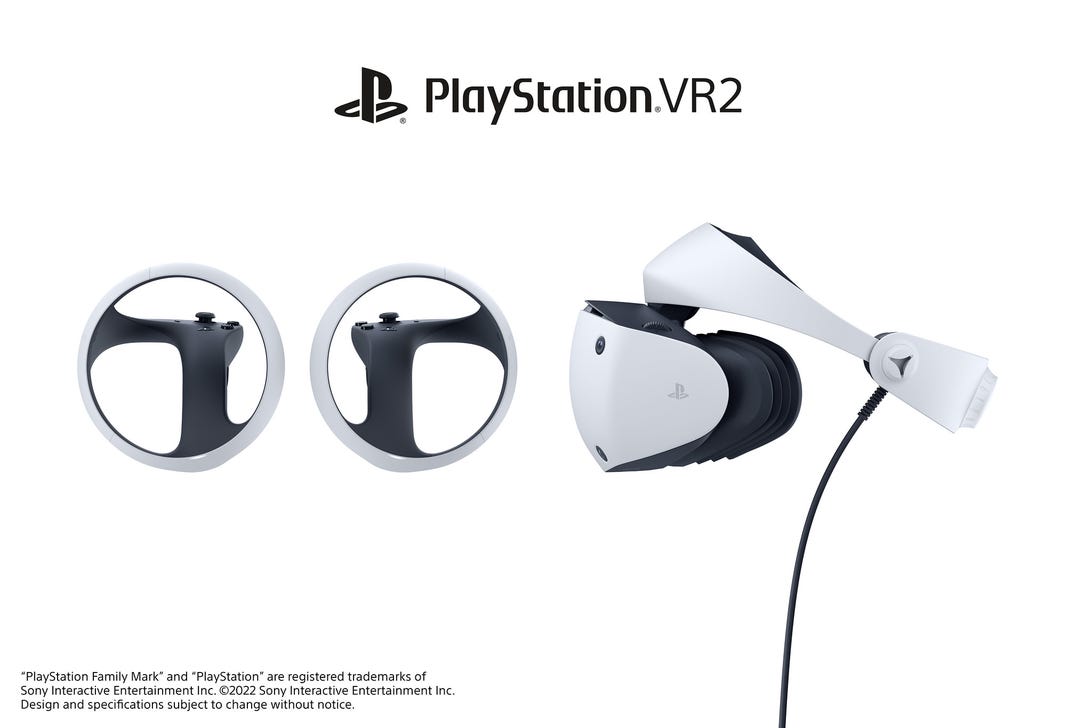PlayStation VR 2 Design Revealed: PS5 Players, Get Excited – CNET [CNET]

Though we’re still waiting to learn a release date and a price for the PlayStation 5‘s next-gen VR headset, Sony has revealed a wealth of key details: the specs, the design and even a confirmed game.
The PlayStation VR 2 looks, in a lot of ways, like the headset we wanted for the PS5 all along. A new design revealed Tuesday shows how the headset has a color scheme that matches the PS5, and a headband-type visor that’s similar to but smaller than Sony’s first PSVR. The high-res, vibrating, camera-equipped, eye-tracking capabilities of Sony’s second-gen PlayStation headset look like they fit the high-end specs anyone would dream of. The one thing lacking, however, is full wireless like the Quest 2. The PSVR 2 is USB-C tethered to the PS5.
Earlier this year at CES, Sony revealed a ton of details about its expected next-gen VR headset, which is an update to the PlayStation VR that Sony released for the PlayStation 4 back in 2016. Sony’s been revealing more details about the headset in little drips and drops: Specs were revealed in January in a detailed blog post, while its funky dedicated VR controllers, which are reminiscent of the PS5’s DualSense controllers, were revealed last year.
We also know about one exclusive game: Horizon Call of the Mountain, which is set in the same universe as Horizon Zero Dawn and Horizon Forbidden West.
The VR headset promises to have unique vibrating feedback and controllers with advanced haptics, along with eye tracking, a 110-degree field of view, and foveated rendering, a technology that focuses only on where the fovea of the eye is looking to maximize resolution, getting more graphics punch with fewer pixels.
Sony’s PlayStation Head of R&D, Dominic Mallinson, suggested eye tracking could be likely back in a 2019 conversation with CNET.
It looks to be one of the big game-changing VR headsets expected in 2022. Here are the key specs we know so far:
- OLED displays, with 2,000×2,040-pixel resolution per eye, 90Hz and 120Hz frame rates
- 110-degree field of view
- Eye tracking, and foveated rendering
- Adjustable lens separation
- In-headset vibration
- 3D audio
- Built-in microphone, and audio-out headset jack
- Four external cameras for tracking
- Single USB-C connection
- Controllers with USB-C ports, Bluetooth 5.1, rechargeable batteries, 6DoF tracking, finger tracking using capacitive touch buttons and infrared, haptics and specialized haptic triggers like the DualSense controller

There’s an adjusting knob on the back to tighten the headset fit.
SonyThe headset design: Vibrations, eye tracking, moving lenses
Even if Sony’s PSVR 2 headset looks bulky in the photos, it could end up being a lot more comfortable than the Quest 2. An adjustable headband, similar to the PSVR’s original design, means it’ll tighten around the head like a visor instead of using an elastic strap to squeeze your face. Sony promises adjustable lens distance for different eyes and faces, too, like the original PSVR had. That type of fit worked really well for my glasses.
The headset supports headphones with a standard headphone jack, and has one cable that tethers to the PS5 via USB-C, via a jack that seems to come out of one side of the headband. That’s a lot fewer wires than the crazy breakout box needed for the original PSVR.
Built-in eye tracking promises to deliver better graphics, and possibly allow eye control and eye contact in VR games. Eye tracking isn’t common in consumer VR headsets yet, but the technology should be arriving on other mainstream headsets, including Meta’s next VR device and possibly Apple’s as well.
The headset’s four tracking cameras will allow movement in VR to be tracked without using a TV-connected camera bar. The tracking should work in a similar way to other VR headsets. It’s possible that the cameras could allow some pass-through mixed reality, too, blending VR with what the cameras see onto the headset’s display.

A side view of the headset, and another angle on the Sense controllers.
SonyWhat we still don’t know: A lot
Even though Sony seems to have dumped a ton of information our way, there are still a lot of unknowns about the PSVR 2 that we hope to find out sooner than later:
How much does it cost?
Sony still hasn’t put a price on the PSVR 2, which suggests it won’t be cheap. The original PlayStation VR cost $400 for just the headset back in 2016. With the PSVR 2’s eye tracking, higher-end display and fancy controllers, this could end up costing at least as much as the PlayStation 5. But that’s all speculation.
When is it coming out?
Sony said the PSVR 2 is coming in 2022, but does that mean by the holidays or sooner? There’s no big rush, but it would be nice to know.
What games will it have?
Sony revealed one PSVR 2 game, but how great will the rest of the lineup be? Sony could dip into its exclusive game library, or get timed exclusives from indie developers. The first PSVR launched with a number of notable games, and the PSVR 2 will need interesting games to sell the hardware.
Will it be backward-compatible with all the old PSVR games?
Odds are, according to reports, it will be backward-compatible with existing PSVR games. That would make sense because PSVR games on PS4 already work on the PS5 with the first-gen hardware. It’ll also help give the new headset a starter library; Sony could also update more of those games with PS5-optimized graphics.
Is there any chance it could be wireless?
Sony confirmed the headset is tethered with a USB-C cable, and you can see the tethered cable in the PSVR 2 photo above. Right now, the answer is no. It’s hard to imagine 360-degree Beat Saber with that USB-C cable attached, but PC VR headsets are cable-tethered, too.

![playstation-vr-2-design-revealed:-ps5-players,-get-excited-–-cnet-[cnet]](https://i0.wp.com/upmytech.com/wp-content/uploads/2022/02/51640-playstation-vr-2-design-revealed-ps5-players-get-excited-cnet-cnet.jpg?resize=800%2C445&ssl=1)
![why-slack-and-salesforce-execs-think-they’re-better-together-[techcrunch]](https://i0.wp.com/upmytech.com/wp-content/uploads/2020/12/16951/why-slack-and-salesforce-execs-think-theyre-better-together-techcrunch.jpg?resize=390%2C205&ssl=1)
![stellar-blade-is-based-on-the-bible,-but-don’t-take-it-too-seriously-[game-informer]](https://i0.wp.com/upmytech.com/wp-content/uploads/2024/04/180229-stellar-blade-is-based-on-the-bible-but-dont-take-it-too-seriously-game-informer.jpg?resize=390%2C205&ssl=1)
![konami-reportedly-returning-to-its-most-popular-(and-neglected)-games-[venturebeat]](https://i0.wp.com/upmytech.com/wp-content/uploads/2021/10/41401-konami-reportedly-returning-to-its-most-popular-and-neglected-games-venturebeat.jpg?resize=390%2C205&ssl=1)